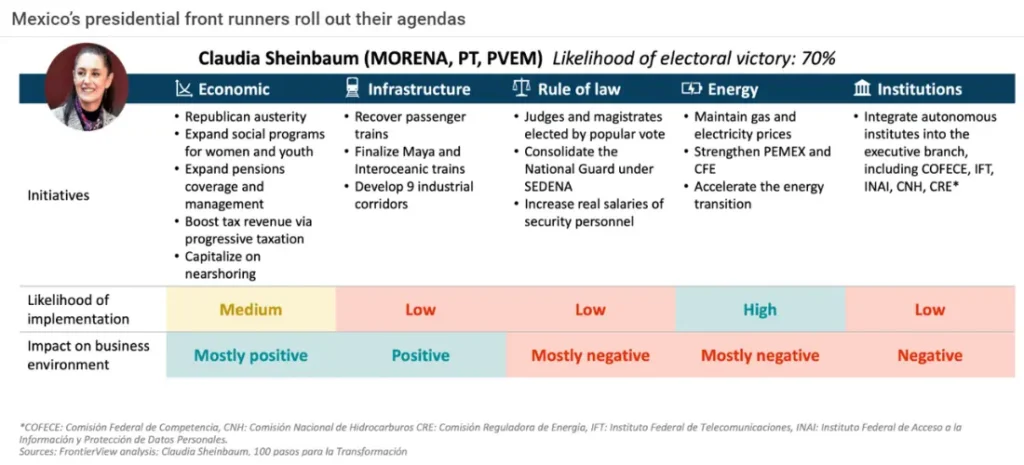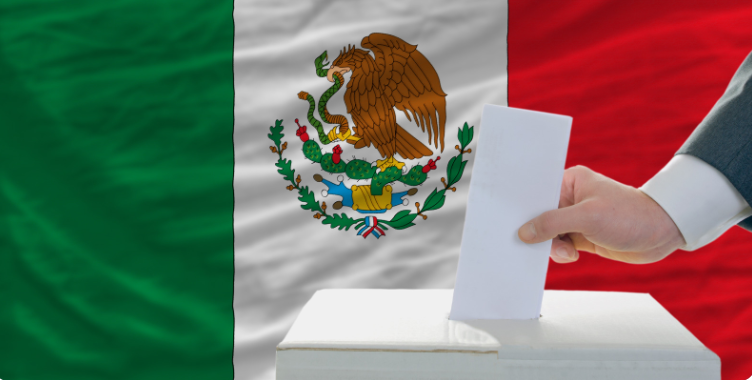
As the electoral campaigns unfold, Mexico’s key presidential candidates are revealing more details about their platforms. If Claudia Sheinbaum (MORENA, PT, PVEM) wins the election—which is our base case scenario—multinational corporations (multinationals) should expect the continuation of flagship infrastructure projects, a strengthening of PEMEX and CFE with a focus on renewables, as well as efforts to integrate autonomous institutes under the executive branch. If our upside scenario occurs and opposition candidate Xóchitl Gálvez (PRI, PAN, PRD) wins, multinationals could expect a relatively business-friendly environment; however, a federal government run by Gálvez could struggle with governance and coordination with subnational entities. In both scenarios, a fiscal reform increasing corporate income taxes (ISR) is likely in the medium and long term.
Overview
Sheinbaum continues to lead voter intention with approximately 50% of votes, while Gálvez remains second with 27%, and Jorge Álvarez Máynez (MC) is a distant third with 8%. Undecided or undeclared voters sum up to 15%.
Claudia Sheinbaum:
- Sheinbaum has committed to maintaining republican austerity, fiscal discipline, Banxico’s autonomy, and increasing tax revenue through fighting tax evasion.
- On the social policy front, Sheinbaum aims to strengthen social spending in existing programs like Jóvenes Construyendo el Futuro and Sembrando Vida. She will also pursue the pension system reform presented by President Andres Manuel Lopez Obrador (AMLO) in 2024, which aims to ensure that workers receive 100% of their salary during retirement.
- On nearshoring, Sheinbaum proposes to consolidate the Interoceanic Train project in Tehuantepec and enhance the capacity of the ports of Coatzacoalcos and Salina Cruz. Additionally, she aims to develop nine industrial corridors across various regions, including the Felipe Ángeles International Airport (AIFA), Gulf, Pacific, Northern Frontier, Baja California, Bajío, Maya, and Center.
- Sheinbaum is pledging to continue with what she calls the “long-term consolidation of Mexico’s energy sovereignty.” However, she also aims to accelerate the energy transition.
Xóchitl Gálvez:
- Gálvez, on the other hand, has focused her campaign on security and the rule of law. Gálvez’ platform emphasizes the rule of law as a key condition for business operations, investment, and job creation. She vows to recover governance in regions where organized crime has expanded.
- Gálvez aims to achieve fiscal consolidation, improve current social programs, invest in the free highways network and cargo railroads, and expand rural roads.
- Gálvez also pledges to create the Agency for Entrepreneurship, Innovation, and Productivity, which would support SMEs with seed funds and technical advisory. She also wants to develop an industrial policy with a special tax scheme for SMEs, reduce red tape, and connect them with large supply chains and productive clusters.
- Gálvez will review AMLO’s inconclusive mega projects and assess the remaining costs. For that, she will create a multi-sectoral board composed of citizens, business leaders, and public servers to plan long-term infrastructure projects.
- On the energy front, Gálvez wants to accelerate the energy transition by supporting energy innovation, increasing efficiency in PEMEX and the Comisión Federal de Electricidad (CFE), strengthening the CFE’s role in energy transmission, and promoting a model of energy federalism in which each state develops its energy policy.
- On the institutional front, Gálvez aims to strengthen autonomous institutes and the judiciary, promote the civil service, and strengthen the autonomy of states and municipalities.
Our View
In our base-case scenario, Sheinbaum wins the presidential election, and MORENA keeps an absolute majority (50%+1) in Congress. In that case, the business environment may benefit from the expansion of social programs, the development of nine industrial corridors, programs to support SMEs, and infrastructure projects to capitalize on nearshoring. However, the business environment could deteriorate if Sheinbaum pursues the integration of autonomous market regulators into the executive branch. Most of these autonomous institutions were decentralized over the last decades to avoid the concentration of regulatory power, particularly in the areas that require significant technical skills, like energy or communications.
In our view, MORENA’s most controversial reforms would be watered down or discarded in this scenario, but these could still deteriorate the operating environment and polarize the political landscape. The reforms to reduce the participation threshold to enable presidential revocation, the reduction of the National Electoral Institute (INE’s) and the Federal Electoral Tribunal (TEPJF) budgets, and the strengthening of popular consultations are likely to be watered down. On the other hand, the popular election of judges and magistrates may be turned down.
Sheinbaum will likely focus on finalizing AMLO’s infrastructure mega projects, expanding social programs, strengthening PEMEX and the CFE with a larger emphasis on renewables, and building new flagship projects, such as a passenger railroad in central Mexico. Sheinbaum may struggle to achieve republican austerity, given the pressures that she could face to expand public projects.
In an unlikely upside scenario, a Gálvez administration would prioritize security and the rule of law, although the results could be noticeable only in the medium to long term. The daunting structural challenges in these areas will remain, but our view is that improving a civilian National Guard—or a federal police force—and strengthening state and local civilian law enforcement could positively impact the business environment in the short and long term. Regarding public infrastructure, Gálvez might take a more frugal approach than Sheinbaum and focus on improving the existing highway and cargo train systems, which could benefit public finances in the long term.
At FrontierView, our mission is to help our clients grow and win in their most important markets. We are excited to share that FiscalNote, a leading technology provider of global policy and market intelligence has acquired FrontierView. We will continue to cover issues and topics driving growth in your business, while fully leveraging FiscalNote’s portfolio within the global risk, ESG, and geopolitical advisory product suite.
Subscribe to our weekly newsletter The Lens published by our Global Economics and Scenarios team which highlights high-impact developments and trends for business professionals. For full access to our offerings, start your free trial today and download our complimentary mobile app, available on iOS and Android.

